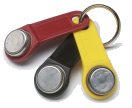 |

|
- Beginner Key (black):
Maximum speed: 6 mph (9.5 km/h)
Slower turning rate
- Sidewalk Key (yellow):
Maximum speed: 8 mph (12.6 km/h)
Medium turning rate
- Open Environment Key (red):
Maximum speed: 12.5 mph (20 km/h)
Most responsive turning rate
|  |

|
Range:
Up to 15 miles (25 km) on a single charge
Accounting for a variety of real-world conditions we expect
you'll be able to travel about 10 miles (16 km) on a single
battery charge. Under severe conditions—such as rugged
terrain or variable speed— we expect you will be able
to travel about 5 miles (8 km). Under optimal conditions, however—no wind,
flat terrain and at constant speed—you could travel as much as
15 miles (25 km).
|

|
Turning
Radius: Zero
One characteristic of a pedestrian is the ability to turn in
place without impacting any nearby person or object, something
no vehicle can do. By balancing on a single axle, Segway HT
users act no differently than pedestrians. The wheels have the
ability to rotate in opposite directions, which enables the machine to
turn in place.
|

|
Payload:
Passenger: 250 lbs (110 kg)
The Segway HT is the optimal short-distance travel solution, with the capacity to carry up to a 250 lb. adult.
|

|
Space:
Platform height: 8 inches (20 cm)
Footprint: 19 x 25 inches (48 x 64 cm)
We designed Segway HT to take up no more space than the average
person. It's no wider than a person's shoulders and raises you
only 8 inches off the ground.

|

|
Weight:
83 lbs (38 kg)
Portability was a key design objective. That's why we made
Segway HT light enough to handle, small enough to store in the
trunk of a midsize sedan, and collapsible enough to fit in
tight storage spaces.

|

|
Power:
Nickel Metal Hydride (NiMH) Battery Packs
The i Series has been outfitted with two 60 cell NiMH battery
packs. The batteries are designed with on-board electronics
that automatically monitor both the condition and temperature
of the batteries. Batteries can be re-charged by utilizing
any 90 to 260 volt and 50 to 60 Hz AC outlet (typically accessible
in most countries). A complete cycle charge will take four
to six hours, which at 10 cents per KW-h, equates to less
than 10 cents of electricity. NiMH batteries are designed
for approximately 300-500 full charge/discharge cycles.
Range, battery life and recharge times can be affected by
factors such as terrain, temperature, speed of operation,
rider weight and load, proper storage techniques and environmental
conditions.

|

|
Safety:
Redundant electrical systems.
Robust mechanical systems.
Safety is our top priority in both design and operation. To
help ensure that both Segway HT users and those near them remain
safe, we built redundancy into the balancing and electrical
systems. If any system begins operating at diminished capacity,
the other is programmed to assume responsibility all the while
maintaining balance while Segway HT slows down to quickly and
safely shut down.
Aircraft design standards were implemented in building Segway
HT's mechanical structures, and each part has been thoroughly
tested and analyzed to ensure such high standards were met.
|
|
|



